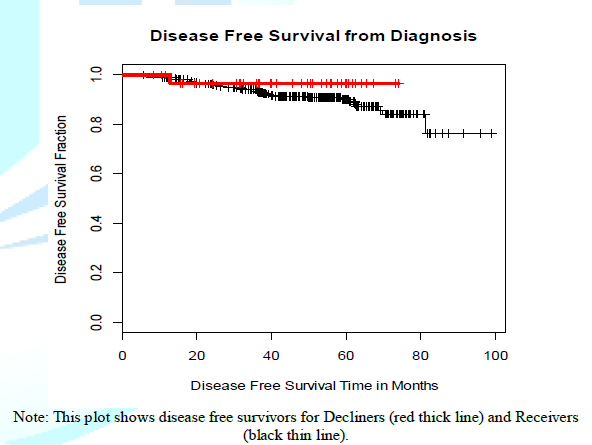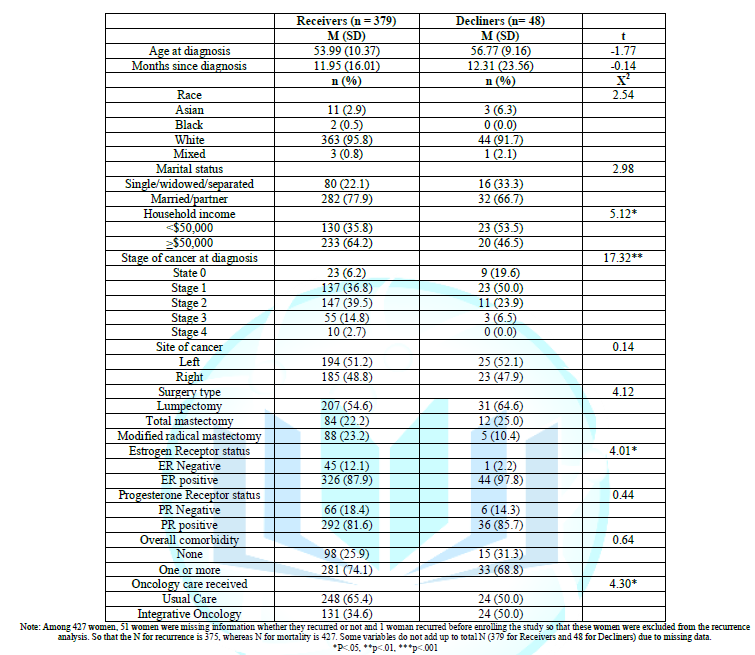Research Article :
Eunjung Kim*, Leanna J Standish and M Robyn Andersen This paper compared Recurrence and Morality rates among women with
breast cancer who received all recommended treatment (Receivers) and who did
not (Decliners). 427 women
were recruited through integrative oncology clinics and the Cancer Surveillance
System (CSS) registry in Western Washington State. Secondary data analysis were
conducted using descriptive statistics, t-tests, X2 tests, and R. Self-reported
data included household income and comorbidity; medical records included dates
of diagnosis, recurrence and last visit with medical oncologist; and CSS
registry data included demographic, disease characteristics, and records on
recommended treatments and receiving/declining them, and date of death. 9% of Receivers and 2% of
Decliners experienced a Disease Free Survival (DFS) limiting event commonly a
recurrence, while 3% of Receivers and 2% of Decliners died. After controlling
for stage at diagnosis and cohort, no difference was found on the Adjusted
Hazard ratio of recurrence or mortality between Receivers and Decliners.
Adjusted Hazard ratio of Decliners relative to Receivers was 0.29 (95% CI; 0.04
– 2.22, p = 0.22) for DFS and 0.50 (95% CI: 0.04, 6.49, p = 0.59) for
mortality. Better
clinical predictors among Decliners may be related to no rate difference in
recurrence and mortality between Decliners than Receivers. Approximately
3.5 million women have breast
cancer in the U.S. and this number goes up each year; in 2019, an estimated
268, 600 women will be newly diagnosed with breast cancer and 41,760 will die
from it [1,2]. However, among these women, about 6-13.8% of women with breast
cancer willingly decline recommended chemotherapy [3-5], 9%
radiotherapy [6] and 14% hormone therapy [7]. Limited evidences suggest that
when women did not receive surgery, relative risk of estimated 10-year
mortality was 1.58 times higher than among Receivers, while the relative mortality was
1.54 times higher when women did not receive chemotherapy [8]. In another study, the risk for having another breast cancer among woman
who did not receive recommended systemic treatments (i.e., chemotherapy,
hormone therapy) was 1.9 times, and risk for death was 1.7 times during an
average 7.3 years of follow-up [5]. Recently, Johnson et al. found that 5-year
survival rate of breast cancer patient was 58.1% among women who did not
receive all treatments, whereas it was 86.6% for women who received all
treatments; Cox hazard ratio was 5.68 [9]. However, lack of information still
existed on the recurrence and mortality of women who did receive surgery but
choose not to receive at least one adjuvant therapy
(i.e., chemotherapy, radiotherapy, hormone therapy) after surgery. Overall
objective of this study was to compare differences in recurrence and mortality
between Receivers and Decliners. In this paper, Receivers indicates women who
received all doctor recommended medical breast cancer treatments including
surgery, chemotherapy, radiotherapy, and hormone therapy. Decliners are those
who voluntarily declined all or part of the doctor recommended adjuvant therapy
(i.e., chemotherapy, radiotherapy, and hormone therapy) after
receiving surgery. This study used longitudinal and correlational study
design. This study reports results from the secondary analysis of the baseline
and 5-year follow up data from the Breast Cancer Integrative Oncology Study, in
which 427 women were recruited through integrative oncology clinics in greater
Seattle area and the Cancer
Surveillance System (CSS) registry in Western Washington State. Sample
criteria included: 1) 18 years of age or older, 2) biopsy-pathology verified
diagnosis of breast cancer or ductal carcinoma in situ, 3) surgery was conducted,
4) their doctor recommended at least one adjuvant treatment among chemotherapy,
radiotherapy, and hormone therapy, 5) clear indication of receiving or
declining recommended treatment, and 6) clear abstracted records of the
following dates: diagnosis, last visit with medical oncologists or recurrence
or second primary
cancer diagnosis (for analysis of DFS), and death as applicable. Data were collected from participants self-reports
(household income and comorbidity), oncologists medical chart review (diagnosis
date, last visit date with oncologists, and recurrence date), and Cancer
Surveillance System (CSS) registry (age and stage at diagnosis, ethnicity,
marital status, Estrogen
and Progesterone
Receptors status, side of breast cancer, receiving/declining recommended
treatments, and last contact/death date if indicated) in Western Washington
State. All data were analyzed using SPSS 20 software and R
Version 3.2.2 [10]. The comparison of survival and DFS between Receivers and
Decliners was analyzed with Cox proportional hazards regression, using the
coxph function in R. For the analysis of DFS time was computed as going from
date of diagnosis to time of DFS limiting event or death for those who did die
but did not recur (n = 2). Those who did not die or recur were censored at the
time last known to be alive and not recurred, i.e. the last visit to the
oncologist. Analysis of survival was similar, except that time of death was
used as the outcome. These analyses controlled for stage of cancer at diagnosis
and type of oncology care received. Kaplan-Meier survival and DFS curves were
generated using the survfit function in R. The
original study obtained the permission from the Institutional Human Subjects
Review Committee of the Bastyr University and Fred Hutchinson Cancer Research
Center and each subject provided informed written consent before participation.
For the current study, the committees from Bastyr University, Fred Hutchinson Cancer
Research Center and the University of Washington
approved to conduct secondary data analysis using a de-identified data set. As shown in Table
1, Decliners tended to have less household income, earlier stage of breast
cancer at the time of diagnosis, more estrogen positive receptor status, and
more frequently received integrative naturopathic oncology
care than Receivers. No other differences were found. As depicted in Table
2, overall 31 women (30 Receivers and 1 Decliner) experienced a DFS
limiting event, commonly a recurrence of cancer and 13 women (12 Receivers and
1 Decliners) died during 5 years of follow-up. The recurrence rate was 9%
(30/334) among Receivers and 2% (1/41) among Decliners, while mortality was 3%
(12/379) among Receivers and 2% (1/48) among Decliners. After controlling for
stage at diagnosis and type of oncology care received, no difference was found
on the Adjusted Hazard ratio of DFS or mortality between Receivers and
Decliners. Adjusted Hazard ratio of Decliners relative to Receivers was 0.29
(95% CI; 0.04 – 2.22, p = 0.22) for DFS and 0.50 (95% CI: 0.04, 6.49, p = 0.59)
for Mortality. Figure
1
shows the Kaplan-Meyer curves for comparing disease free survival time between
Receivers and Decliners, which was not statistically significant. The x-axis
represents time since diagnosis and y-axis represents the fraction of women who
are alive and disease free at each time. All women (100% or 1.0 fraction) start at the top of
the y-axis, indicating all women, at the time of diagnosis, have not
experienced DFS limiting event or death. The lines go down at the times at
which a woman in that group died or experienced a DFS limiting event. Women
who did not die or recur are shown in the plot as a small vertical tick mark
which indicates the time at which that woman was censored, i.e. the time at
which she was last known to be alive and disease-free. Red thin lines represent
Decliners and black thin lines represent Receivers. Figure
1: Disease free survival between Receivers and Decliners. Overall, the recurrence rate was 9% among Receivers
and 2% among Decliners, while the mortality rate was 3% among Receivers and 2%
among Decliners. These rates are much lower than Saquib et al.s finding; they
found recurrence rate of 6.63% for Receivers and 19.21% for Decliners and
mortality rate of 10.14% for Receivers and 11.30% for Decliners [5]. The
Adjusted Hazard Ratio of 0.29 for recurrence and 0.50 for mortality in the
current study is much lower than the ratio of 2.35 for recurrence and 3.05 -
5.68 for mortality found in previous studies [5,9]. This difference may be
related to data collection time; Saquib et als data were from 1995 - 2000 and
Johnson et al.s data were from 2004 - 2013, whereas our data were from 2012 -
2017. In looking at the difference in findings where we
found non-significant differences such that Decliners did not
demonstrate poorer outcomes, this may be in part because Decliners in this
study tended to have earlier stage of cancer at diagnosis and more estrogen
positive receptor status. Suggesting that Decliners in this study may have been
aware that their risks of poor outcomes were low when they choose to decline adjuvant treatment. However,
for R analyses this study controlled the stage of cancer at diagnosis, and when
these adjustments were added the non-significant differences remained but were
reduced. It is possible that decliners had more detailed knowledge of their
condition from their doctors than we could control for using stage. Of note also might be the fact that participants in
this study were predominantly white women living in an urban area with good
access to medical care who generally received guideline consistent care and
reported having been very involved in making decisions about their treatment [11].
Our previous study found that overall, 11.2% (48/427) of women declined at
least one adjuvant treatment recommended by their medical doctors after their
surgery; 8.8% (22/251) chemotherapy, 10.5% (33/314) radiotherapy, and 13.3%
(45/339) hormone therapy. Decliners of conventional adjuvant treatment in this
study were very involved in their treatment decision making, compared with Receivers. In this context, Decliners in this study were
generally women who choose not to receive one or more adjuvant therapies
on a therapy by therapy basis and did not include women who were denied
treatment based on counter indications due to co-morbidities or poor health, or
lack of access [11]. These data may thus present a best-case scenario for
self-determination and patient informed decision-making about adjuvant care. Study participants were mostly White Americans and
the sample size for Decliners was much smaller than Receivers. Repeating the
study with more women who have more diverse, income, educational, ethnic and
cultural backgrounds would be important. There were 51 women whose recurrence
status was missing in medical record, which decreased sample size. Recording recurrence
of all individuals with cancer would be important. And it would be nice if
these data are collected by CSS registry. Some Receivers may not 100% adherent
to all adjuvant treatments; conversely some Decliners might have received some
adjuvant treatments later; however, this information was not collected. Our study found no significant difference,
suggesting that in some cases Decliners may be patients
with good prognosis; receiving treatment in their case would represent
over-treatment. To our knowledge, this is the first study that demonstrated no
statistically significant difference in the rate of recurrence and death
between Receivers and Decliners. This finding is not congruent with earlier
studies that have shown that Decliners were at a higher risk of recurrence or
death. And it is not clear why the results were not consistent, although we
have attempted to present some possible explanations. Acknowledgement This
paper discusses secondary analysis using the data from the Breast
Cancer Integrative Oncology: Prospective Matched Controlled Outcomes Study
which was awarded to Drs. Andersen and Standish, from NIH, NCCAM, R01 AT005873. *Corresponding author: Eunjung Kim, Department
of Family and Child Nursing, University of Washington, USA, Tel: 206-543-8246,
Fax: 206-543-6656, Email: eunjungk@uw.edu Breast cancer, Recommended conventional
treatments, Receivers, Decliners, Recurrence, MortalityRecurrence and Mortality Rates Among Receivers and Decliners of Conventional Adjuvant Breast Cancer Treatments
Abstract
Objectives: Full-Text
Highlights
Introduction
Methods
Design,
sample, setting, and procedures
Instruments
Data
sources
Data
analysis
Ethical
Considerations
Sample
Characteristics
Recurrence
and Mortality

Discussion

Limitations
Conclusion
References
Keywords